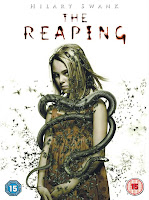

She seems to have lost the hair on her temples, but gained a lot of cats on her sleepsuit. I also think her head's changed shape. It now looks less like a turnip and more like a melon, which can only be a good thing. Unless it means she's got water on the brain.
I wheeled Amelie into town yesterday afternoon to meet Lisa, who'd escaped for a couple of hours against her daughter's will. We managed to track her down near the Royal Pavilion, where she introduced us to a friend of hers. The friend admired Amelie for a couple of minutes, before saying "I wonder if she'll have her mother's sense of humour?". We can only hope so. Frankly she'll need it if she's going to survive the next eighteen years.
 But that aside, the good thing about having two days off work is that it gives you time to watch rubbish DVDs you bought on the cheap, in the mistaken belief that anything starring Hilary Swank ought to be ok, and not a steaming pile of hokum that feels like it was written by a dyslexic twelve-year-old goth. Ladies and gentlemen, I give you The Reaping. You might have seen it in HMV for a fiver. Don't be tempted. Trust me, five items from the pound shop would contain more quality.
But that aside, the good thing about having two days off work is that it gives you time to watch rubbish DVDs you bought on the cheap, in the mistaken belief that anything starring Hilary Swank ought to be ok, and not a steaming pile of hokum that feels like it was written by a dyslexic twelve-year-old goth. Ladies and gentlemen, I give you The Reaping. You might have seen it in HMV for a fiver. Don't be tempted. Trust me, five items from the pound shop would contain more quality.Apparently the filming of the movie was halted for a week when Hurricane Katrina hit the production mid-shoot. I think it was God's version of a subtle hint. But having spent ninety-five minutes wishing that the devil really was after Hilary Swank, I have to say that the film did contain one entertaining moment. It was the bit where the main character explains away the Ten Plagues of Egypt, as featured in the Book of Exodus, the sequel to Genesis, which was the first book God ever wrote.
For those who didn't go to Sunday School, the Ten Plagues of Egypt were: rivers of blood, frogs, lice, flies, dead cows, bad skin, inclement weather, locusts, darkness and death of the first born.
So here's what Hilary Swank had to say about it all:
"In 1400 B.C. a group of nervous Egyptians saw the Nile turn red. But what they thought was blood was actually an algae bloom, which killed the fish, which prior to that had been living off the eggs of frogs.
Those uneaten eggs turned into record numbers of baby frogs who subsequently fled to the land and died.
Their little rotting frog bodies attracted lice and flies.
The lice carried the bluetongue virus, which killed 70% of Egypt's livestock.
The flies carried glanders, a bacterial infection which, in humans, causes boils.
Soon afterwards, the Nile River Valley was hit with a three-day sandstorm, otherwise known as the plague of darkness.
During the sandstorm, intense heat can combine with an approaching cold front to create not only hail, but also electrical storms which would have looked to the ancient Egyptians like fire from the sky.
The subsequent wind would have blown the Ethiopian locust population off course and right into downtown Cairo.
Hail is wet; locusts leave droppings. Spread both on grain, and you have got mycotoxins. Dinnertime in ancient Egypt meant the first-born child got the biggest portion, which in this case meant he ate the most toxins, so he died.
Ten plagues. Ten scientific explanations."
Next they'll be claiming The Da Vinci Code isn't real.












0 comments:
Post a Comment